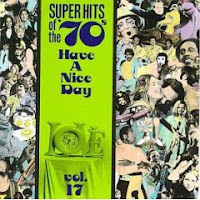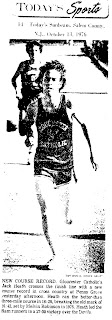One of America's greatest Olympic champions was a South Jersey native who ran his first race as a Philadelphia schoolboy.
He was a fierce competitor whose humble background and dogged determination made him a personal favorite of President Theodore Roosevelt.
He was a former street tough - a self-styled member of the "Grays Ferry Roaders" gang in South Philadelphia around the turn of the 20th century - who ran so fast and so well that U.S. middle-distance stars have been chasing his accomplishments for a century.
And they haven't caught him yet.
One hundred years ago today, Mel Sheppard won the first of his three gold medals at the Olympic Games in London. A century later, Sheppard remains the last American to win a gold medal in the 1,500 meters.
Sheppard also won the 800 meters and anchored the U.S. sprint medley relay team to a victory in those Games. At the 1912 Olympics in Stockholm, he won a gold medal in the 4x400 relay and a silver medal in the 800.
Four Olympic gold medals, three in world-record time. An Olympic silver medal. Seven AAU national titles. World indoor records in the 600 and 1,000 yards.
All that athletic glory springing from such an unlikely background - plus an eyewitness brush with the aftermath of the sinking of the Titanic - make Sheppard one of the more compelling characters to emerge from the Philadelphia area.
But 100 years is a long time: Today, Sheppard might be the most famous athlete that most people never heard of.
"He should be our Steve Prefontaine," said longtime Haddonfield track and cross-country coach Nick Baker, referring to the late Oregon running star.
Sheppard was born in 1883 in Almonesson, a section of Deptford Township in Gloucester County. He lived there, in a twin house, for the first nine years of his life.
"What I remember most is swimming in Almonesson Lake," Sheppard wrote in his autobiography, Spiked Shoes and Cinder Paths, which was published in serial form in Sport

Story magazine (newstand price: 5 cents) in 1924.
At the time, Almonesson Lake was a rural body of water popular with fishermen and young boys who would tie ropes to trees that grew near the shoreline. For most of the first half of the 20th century, Almonesson Lake was a recreation spot for boaters and swimmers, with amusement rides near the current location of Auletto's Caterers.
At age 9, Sheppard moved with his family to Clayton, and got a job "rolling jars" in a glass factory for $9 a month. His family moved to Haddonfield a few years later, then to the Grays Ferry section of Philadelphia when Sheppard was about 15.
Sheppard wrote that he had jobs "pulling tacks out of shoes" and as a messenger boy, but that he also joined the Grays Ferry Roaders, a street gang that clashed with rival gangs such as the Ramcats, Pine Streeters and Race Streeters.
Sheppard wrote that the Ramcats were his gang's "special enemies, with whom we would fight when we had nothing else to do."
Sheppard's emergence as a world-class athlete was astoundingly sudden. When he was 17, his family moved to West Philadelphia, near Fairmount Park, and he joined the Preston Athletic Club.
About the same time, he enrolled in Brown Preparatory School, in the Odd Fellows Temple at Broad and Cherry Streets. The building, erected in 1893 at a cost of $1 million, was demolished in 2007 to make way for the Convention Center expansion.
Sheppard wrote that his first race was a 100-yard dash in Washington Park in Philadelphia. He finished third.
"The longer races were more fit to my nature," Sheppard wrote.
In 1904, Sheppard won three races while representing Brown Prep at schoolboy events held in conjunction with the Olympics in St. Louis - a foreshadowing of his success four years later in London.
Sheppard qualified for the 1908 U.S. Olympic team by winning the 800 meters in the Olympic trials, which were held at Franklin Field.

He set sail for London on June 29 with about 100 other members of the U.S. team on the liner Philadelphia. He wrote that the track team trained on "a cork track on the promenade deck," and noted that javelin throwers amused themselves by tying ropes to their spears and throwing them at sharks that approached the ship.
The 1908 Games were the first to have an opening ceremony. About 2,000 athletes, representing 22 countries, competed.
There was a fierce rivalry between the American and English teams, fueled when American shot-putter Ralph Rose did not dip the U.S. flag in salute to King Edward VII. Rose's refusal became standard practice for U.S. athletes in the opening parade.
Sheppard was a surprise entrant in the 1,500 meters - he hadn't even run the event in the trials - but won his heat in 4 minutes, 5 seconds. The next day, he set a world record by winning the final in 4:03.5.
"
If it was necessary to die at the finish, why, that would be perfectly satisfactory as long as I hit the tape first," Sheppard wrote. "It was the proudest moment of my life."
Sheppard won the 800 meters in 1:52.4, another world record. And he was the anchor man on the sprint medley relay team that won another gold medal.
About a month later, Sheppard and the rest of the U.S. team were invited to meet President Theodore Roosevelt at his summer home in Oyster Bay, N.Y.
"The president was particularly interested in Mel Sheppard and asked for him several times," the New York Times reported Sept. 1, 1908. "The great middle-distance runner was compelled to describe his races . . . and the president listened with great attention."
Roosevelt was particularly interested in the 1,500 meters, which he called "the greatest race I ever read about." Sheppard told the president about the event, then pulled a Moroccan leather case out his pocket and handed it to the man known as the Rough Rider.
"This is my prize for winning the event," Sheppard said of his gold medal. "I would be honored if you would keep it."
When Roosevelt refused, Sheppard said, "I have two others, and I will not miss this one."
When Roosevelt accepted, he told Sheppard, "This will be one of my most treasured

possessions."
In his autobiography, Sheppard described Roosevelt's reaction this way: "The president was like a schoolboy who won his first ribbon."
Sheppard later wrote to Roosevelt asking for help in acquiring a job as a customs inspector at the Port of Philadelphia. Roosevelt's personal secretary wrote back, and Sheppard got the position.
He later was transferred to the Port of New York, and he was on duty the night of April 18, 1912, when the RMS Carpathia arrived with the survivors from the sinking of the Titanic.
From 1906 to 1912, Sheppard was America's best middle-distance runner. He won
seven AAU national titles, and barely missed another gold medal in the 800 meters at the 1912 Olympics. His time of 1:52 would have been another world record, but teammate Ted Meredith edged him at the tape and won in 1:51.9.
When his running career ended, Sheppard turned to coaching. He was a civilian athletic director at military bases during World War I. He served as a field secretary for the Playground and Recreation Association of America, traveling the country to help set up leagues and playgrounds. He was the coach of the U.S. women's track team at the 1928 Olympics in Amsterdam.
For the last 20 years of his life, Sheppard worked for Wanamaker's in New York as recreation director of the Millrose Athletic Association. He died in 1942 in Queens, N.Y., at the age of 59.
"He was kind of a rough-and-tumble individual," said Howard Schmertz, 83, who served as meet director of the Millrose Games from 1975 to 2003.
Schmertz's father directed the Millrose Games from 1934 to 1974, and was an attorney for Wanamaker's during Sheppard's time with the Millrose Athletic Association.
Looking back, Schmertz said, "In those days, everybody knew Mel Sheppard."
Note: A yearly South Jersey cross country banquet is held every fall in Almonesson with close to a thousand in attendance. Ironically, at the banquet there is no mention or thought for the former Olympic Gold medal winner Sheppard-- a fellow distance runner who once lived only blocks away. At present there are no town memorials or monuments to Sheppard nor is there a memorial race in Shepards honor in his home town of Almonesson or Deptford NJ.






















.JPG)




